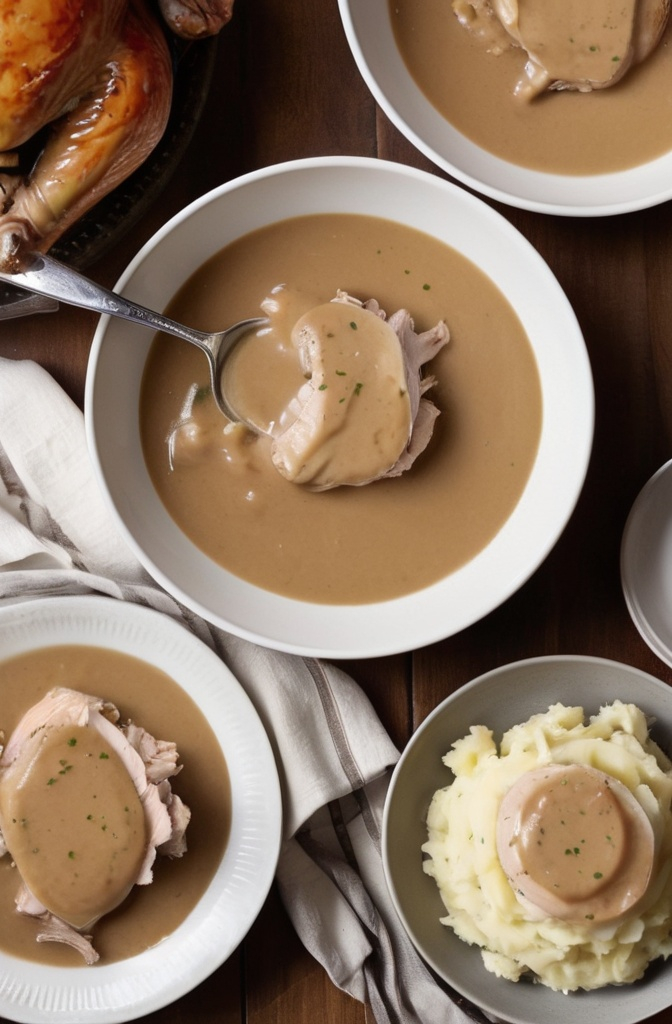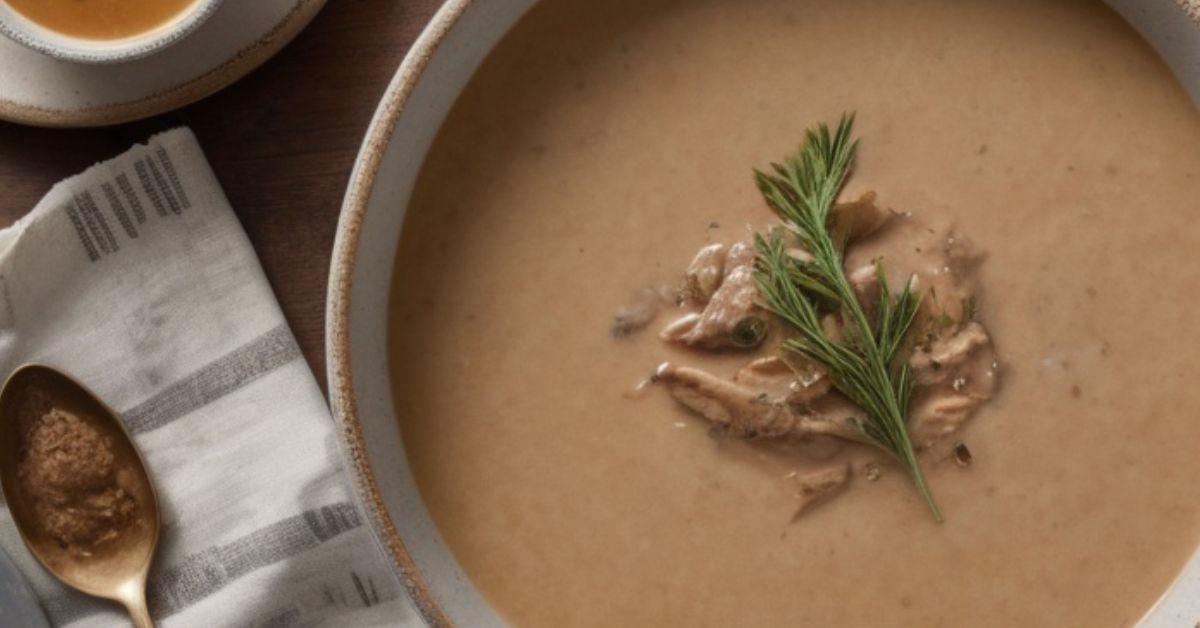Turkey Gravy Recipe lemme tell you something odd. One Thanksgiving, the turkey came out perfect golden, juicy, textbook beautiful but the damn gravy? Clumpy, pale, tasted like wet cardboard. My brother still brings it up every year.
It haunts me. But that failure? It led me down a rabbit hole. Stock reductions, roux ratios, fat clarifications. Obsessive gravy practice. I’m talkin’ turkey necks at 2 a.m.
What I learned is this: Turkey gravy isn’t just a sauce. It’s a litmus test. A magnifying glass for technique. A reflection of care.
This is the ultimate turkey gravy recipe. No cornstarch shortcuts. No flavorless jar stuff. We’re building layers of flavor from real drippings, roasted bones, and a bit of culinary intention. The method leans classic French, with a few sharp left turns. Subtle techniques that make all the difference when you’re cooking at a professional level or just pretending to be one when the in-laws are over.
What Makes This Turkey Gravy Special?

We use a double stock method starting with a rich roasted turkey stock, then reducing it with fresh pan drippings.
The roux is slow-cooked for depth, not just thickening. We build it like a brown butter almost nutty.
We also finish with a splash of sherry vinegar or white wine, to cut the fat and add brightness. It’s a whisper of acid, not a shout.
Optional, but transformative: a teaspoon of miso. Yep. Miso. Umami bomb.
This is gravy that stands on its own spoon.
Ingredients & Substitutions
- 2 tablespoons turkey fat (from the roasting pan)
Sub: Unsalted butter or ghee works too, but the turkey fat carries the soul. - 2 tablespoons all-purpose flour
Sub: For gluten-free, go with sweet rice flour or a 1:1 GF blend avoid almond flour, it’ll clump. - 2 to 3 cups turkey stock (preferably homemade, recipe below)
Sub: Chicken stock in a pinch. But please, not boxed broth with “natural flavors.” It’s just sadness in a carton. - Pan drippings from roasted turkey
Optional but ideal scrape every bit from that roasting pan. - 1 small shallot, minced finely
Sub: Yellow onion, though shallot gives a softer, more delicate finish. - 1 teaspoon miso paste (optional)
Adds savory depth. You won’t taste it outright, but you’d miss it if it’s gone. - Splash of dry sherry, white wine, or sherry vinegar
Just a dash. Balances richness. - Salt and freshly cracked black pepper, to taste
Don’t go wild on salt until you’ve added the drippings they pack sodium.
Turkey Stock (Make-ahead, ideally)
- 2–3 lbs turkey wings, necks, or backbones
- 1 large carrot, chopped
- 2 celery ribs
- 1 onion, halved (leave the skin on for color)
- 2 garlic cloves, smashed
- 1 bay leaf
- Few sprigs thyme
- 10 black peppercorns
- Cold water to cover
Roast bones and veg at 400°F for 45 mins, then simmer in a large pot of water for 4–6 hours. Strain, cool, and skim fat if needed.
Pro tip? Reduce it down by half. It’s gold. Liquid turkey essence.
Step-by-Step Instructions
- Separate the turkey fat from the drippings.
Let the pan juices settle. Skim the top layer of fat—this is your base. If you’re short, butter steps in. - Make the roux.
In a saucepan, combine fat and flour over medium heat. Whisk constantly. You’re aiming for a blond to light brown roux—think peanut butter. This takes about 5–7 minutes. If it smells like warm toast, you’re doin’ it right. - Sweat the shallots.
Add them to the roux and cook for another minute. Not browned, just translucent and fragrant. - Deglaze.
Splash in your sherry or wine. It’ll hiss and steam. Scrape up anything stuck. - Slowly whisk in the warm stock.
Don’t dump it all at once or you’ll get lumps. Gradual, steady, whisking the whole time. - Add pan drippings.
Stir them in and let the gravy simmer gently. About 10–15 mins until thickened. Not gloppy. Think rich soup consistency. - Taste. Season. Finish.
Add your miso now, if using. Adjust salt, pepper, and acidity. A squeeze of lemon works in place of vinegar if you’re out.
Cooking Techniques & Science
Why a roux instead of a cornstarch slurry? Because texture matters. Roux gives a satiny, emulsified body that clings to turkey like a tailored jacket. Cornstarch is quick but it’s shiny, slick, and breaks down fast.
And stock. Oh boy, the stock.
Boxed stuff tastes like wet paper. A good homemade turkey stock reduces beautifully and gives that gelatinous mouthfeel. That’s collagen, baby. It’s what gives restaurant sauces their “I don’t know why this is so good” quality.
Why roast the bones? Maillard reaction. It creates umami-rich compounds browned bits that translate to flavor depth.
And that sherry vinegar? It’s not traditional. But it cuts through the fat like a laser and gives the gravy some lift. Fat without acid is like bass without treble boomy and flat.
Tools That Make a Difference
- Fat separator: Helps you get clean turkey fat fast.
- Fine mesh strainer: Ensures a silky-smooth finish.
- Whisk: Crucial. Forks won’t cut it.
- Ladle: Portioning is cleaner and makes plating way prettier.
Serving & Pairing Suggestions
Pour over sliced turkey, of course. But don’t stop there.
Ladle it over:
- Creamy mashed potatoes with chive butter
- Buttermilk biscuits
- Leftover stuffing (yes, even cold)
- Hot open-faced turkey sandwiches the next day
For presentation? A warm gravy boat with a ladle. Or, go rustic and serve in a small cast iron skillet. A sprig of thyme floating on top doesn’t hurt.
Wine Pairing Tip: Turkey gravy loves pinot noir. The earthiness matches the savoriness beautifully. A dry cider also works if you wanna go lighter.
Why This Gravy Works (And Others Don’t)

Most gravies fail in one of three ways:
- Too thin – Often undercooked or poorly thickened.
- Too salty – Because boxed broth and salted drippings stack up.
- Flavorless – No foundation of roasted stock or proper seasoning.
This method avoids all that. The layered flavor, the proper fat-to-flour ratio, the acid balancing the fat. It’s all intentional.
FAQS About Turkey Gravy Recipe
1. Can I make turkey gravy ahead of time?
Yes, absolutely. Make it up to 3 days in advance. Reheat gently over low heat and whisk to bring it back together.
2. What if my gravy is lumpy?
No stress. Strain it through a fine mesh sieve or blend it briefly with an immersion blender.
3. How do I thicken gravy without flour?
Use arrowroot powder or a beurre manié (butter mixed with flour) stirred in at the end. Or reduce the stock further before using.
4. My gravy is too salty what can I do?
Add unsalted stock or water to dilute. A splash of cream or a potato chunk simmered in can also absorb excess salt.
5. Can I freeze leftover gravy?
Yep. Freeze in small portions. It may separate when thawed, but a quick whisk over heat brings it back.
Gravy isn’t garnish. It’s glue. It’s the thing that makes turkey not boring, ties every element of the plate together, and makes stuffing taste like something that’s been kissed by angels.
Master this, and your turkey dinner will go from “pretty good” to “are you opening a restaurant?”
Want the stock recipe in more detail or need help with gravy troubleshooting?
Final Tips And Creative Variations
- Want it spicier? Add a pinch of cayenne or Aleppo pepper.
- Mushroom gravy? Add sautéed creminis during the roux stage.
- Vegan version? Use roasted vegetable stock, olive oil, and a touch of soy sauce or mushroom powder for umami.
And for the love of gravy don’t let it sit uncovered. Gravy films over quick. Keep it warm in a covered saucepan or thermos until ready to serve.




